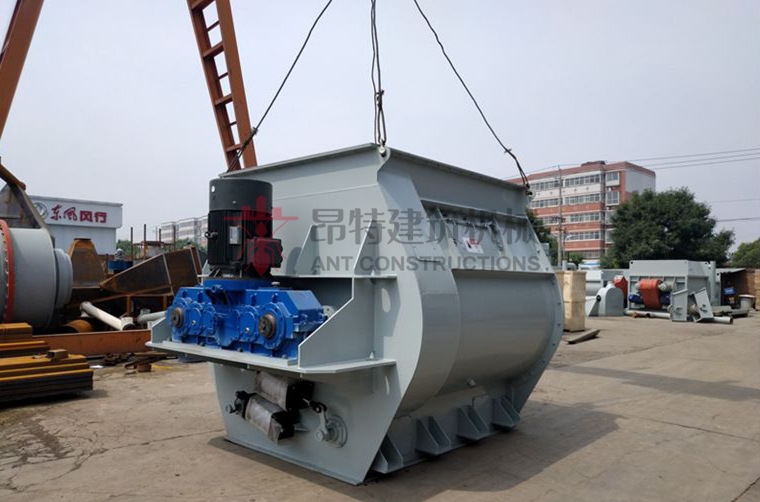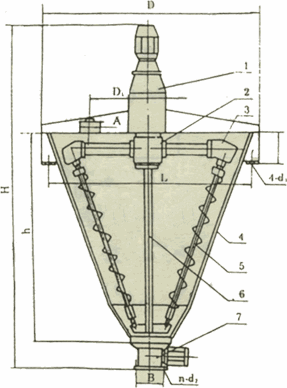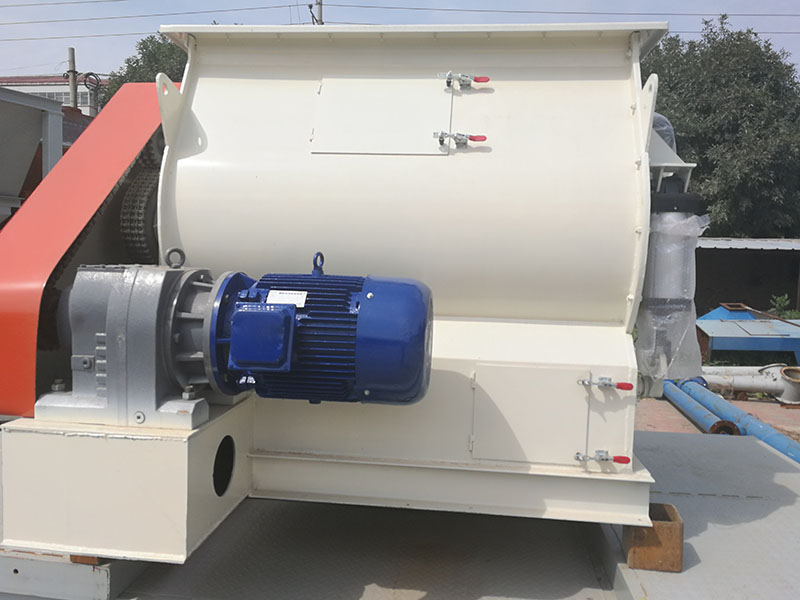How to choose suitable dry mortar mixer machine
Author:ANT CONSTRUCTIONS Comefrom: Createdate:2020/11/12 9:14:51 Hits:65
How to choose suitable dry mortar mixer machine

With the continuous development of China's industry, dry mortar mixer machine is an indispensable mechanical equipment for modern industry, the development of mixing systems and mixing machine become more and more powerful. Dry mortar mixer is applicated in entire industrial field, such as chemicals, food, building materials, medicines, and fertilizers. Almost all the products we are daily consumed are used dry mortar mixer machine in one of the process.
General introductions of mixing and dry mortar mixer machine
Mixing process is the physical joining of two or more materials without any chemical changes.
Mixing includes gravity mixing and mechanical stirring. Gravity mixing is the movement between materials, uniform mixing finish by their own friction; mechanical mixing is finish uniform mixing of the materials through mechanical force. General mixing is gravity influence self flow mixing; three-dimensional mixer machine is a combination of gravity mixing and mechanical mixing; in all mixing process, the mixer tank not moving belongs mechanical mixing.
The evaluation of mixing machine is based on different physical quantities.
Mixing uniformity: it is the major evaluation standard of mixing finish quality, mixing uniformity obtained by probability theory, and the mixing uniformity is determined by the mixer machine type.
Dead angle: It refers to the physical phenomenon that materials cannot participate in the mixing in the mixing container. The percentage of dead angle is the physical standard for evaluating the quality of the dry mortar mixer machine.
Mixing time: It is the evaluation standard of the mixing speed, it refers to the consumed time from mixing start to different materials reach the best mixing uniformity. The mixing time is determined by the type and model of the dry mortar mixer machine
The choice dry mortar mixer machine typex
There are many types dry mortar mixer machine, here we mainly introduce the double spiral cone mixer, horizontal non-gravity mixer, horizontal coulter mixer, and horizontal ribbon mixer that are commonly used in the Chinese market in mechanical mixing machine:
1. Double spiral cone mixer

The mixing space is an inverted cone shape. There are two, three or single spiral shafts inside the barrel that revolve along the barrel wall while rotating, and power devices such as motor and reducers are located at the upper end of the mixer.
Spiral cone mixer are wide applications, density deviation and particle size deviation of the mixing materials are applicable, and it is easy to control the friction heating or static electricity of the materials. The damage to crystals is small when mixing materials.
The power requirements of the equipment are low when mixing, and the motor power of the equipment of the same model is greatly reduced. The spiral cone mixer volume can be expanded to a very large size, 30 cubic meters spiral cone mixer being used in China.
The mixing time is quite long, but the large mixer can be made in triple helix which can greatly shorten the mixing time.
It is main applicated in the mixing of powders and powders. A large amount of liquid can be sprayed into the material during mixing, but the material is as solid powder during the whole process of mixing. Application include dyes, MSG, additives, plastic particles, etc.
2. Horizontal non-gravity mixer

The mixing space is in the form of twin U-shaped cylindrical drums. There are two horizontal shafts in the drum. A bladed arm extends from the shaft. The two mixing shafts rotate in opposite directions. The motor reducer is on the side of the main equipment.
Mainly powder, mixing between particles, not suitable for mixing light materials
Due to the large-scale movement of the material during mixing, the crystals of the material will be damaged in a small area.
When the equipment is mixing, all materials are in a high-motion state, and the power requirements are high.
The mixing time is faster in mechanical mixing equipment.
China's domestically produced products are 20 cubic meters.
The main application is the mixing of powder and powder. The material to be stirred can be in the form of particles, and a small amount of liquid can be sprayed into the material during mixing, but the material is reflected as solid powder during the whole process of mixing. Application example: Dry-mixed mortar , Salt, fertilizer, etc.
3. Horizontal coulter mixer
The mixing space is in the form of a horizontal drum, and there is a horizontal shaft with a coulter in the barrel; there are a large number of high-speed flying knives on the side of the barrel, which are 90 degrees to the main mixing shaft, and the motor reducer is at the end of the main equipment .
Due to the high-speed movement of the flying knife during stirring, the crystals of the material are destroyed to a great extent.
The power requirements are medium, and the mixing time is medium.
China's domestically produced products are 20 cubic meters.
The main application is the mixing of powder and powder. The stirred material can carry a small amount of short fibers, and a small amount of liquid can be sprayed into the material during stirring. Application examples: Building materials, fiber dry powder mixing, etc.
4. Horizontal ribbon mixer
The mixing space is a horizontal U-shaped barrel with an integral spiral ribbon shaft inside the barrel. The motor reducer is on the end face of the main device.
The stirring is relatively stable, and the damage to the crystal is small.
When the equipment is stirred, all materials are in a state of overall movement, and the power requirements are high.
The mixing time is relatively short.
The main application is the mixing of powder and powder or viscous materials. A large amount of liquid can be sprayed into the material during mixing. The material body can reflect solid powder or viscous during the entire mixing process. Application examples Thickening powder, gray surface, paint, etc.
Three, the choice of the size of the mixing equipment
As far as the size of the mixing equipment is concerned, it is currently 30 cubic meters in China, and the main production areas are Shanghai, Zhejiang and Sichuan. Regarding the requirements of mixing technology and mixing volume, mixing equipment can be divided into experimental type 0.05~0.5 cubic meters; production type 0.5-6 cubic meters; batch type 4-30 cubic meters;
Experimental equipment
Production capacity requirements are not high, and experiments or experimental production are mainly carried out in the early stage of enterprise investment.
Production equipment
High production capacity requirements, mainly for enterprises to invest in the production of products, such equipment has high relative strength design, no high power requirements, and other production equipment, including batching, automatic feeding, automatic discharging, and manufacturing a complete mixing production line. The efficiency is quite high and the investment is relatively low. According to the production requirements, one set of production line produces one or two products without long-term replacement of the product form. The equipment realizes the assembly line, which replaces the technical requirements of large equipment for large production volumes.
Batch equipment
It is mainly used in places where the mixing batch requirements are very strict, such as dyes, food, etc. The same batch of products cannot have special requirements such as color and taste differences.
Fourth, the choice of mixing auxiliary function
According to different mixing process requirements, the mixing of materials requires different mixing methods and mixing environments. The mixing equipment is designed with many auxiliary mixing functions according to different mixing methods, and different auxiliary functions are selected according to different mixing requirements.
Heating or cooling
During the mixing of materials, heating is a common phenomenon.
① The mixing process of some materials can only be realized in a certain temperature environment, in order to meet the raw mixing ability of the materials, and to improve the uniformity of mixing.
②Some mixing materials themselves contain a certain amount of moisture. During the mixing process, the moisture can be dried by simple methods such as increasing the temperature to achieve simple mixing and drying in one step.
For mechanical dry powder mixing equipment, heating or cooling the shell of the mixing container to ensure that the mixing container is at a constant temperature during the mixing process is the main method of heat preservation for the mixer. The traditional name is jacket.
According to different temperature requirements, the common heating methods are: ①Add heat transfer oil in the jacket, and the heating wire directly heats the heat transfer oil ②Circulating oil heating ③Steam circulation heating
In order to improve the efficiency of energy utilization, the heating jacket shell needs to be insulated with another layer to prevent heat energy from being dissipated into the air. In order to meet the heating requirements of the mixing process, the equipment generally requires auxiliary boilers or other energy equipment. In order to eliminate the steam or other emitted substances generated by heating during the mixing process, the system also needs to be equipped with a set of induced air system and dust removal system.
Vacuum or pressurize
During the mixing process, the materials may be oxidized or other processes that cannot be completed in the air state, the mixing equipment container needs to be vacuumed, and inert gas protection needs to be filled when necessary.
For example, during the stirring process of explosives, it is necessary to extract all oxygen elements in the stirring container, and then fill the container with argon or other inert gas to prevent friction and heat generation during the stirring process and explosion.
Spray
In order to meet the requirement of adding a small amount of liquid during the mixing process of the dry powder, and at the same time, the uniformity of the liquid and the powder must be improved.
For example, when we stir the gray surface, if the water and gray surface are put into the container and then mechanically stirred, it will be difficult to stir evenly; if the gray surface is mechanically moved, the water is brought into contact with the gray surface in a mist, and the mixing is uniform The temperature and mixing time will be greatly improved.
Flying knife equipment
If there are fibers or other difficult-to-disperse materials in the mixing material, high-speed dispersion is required during the mixing process, and the mixing equipment needs to be designed and manufactured with a high-speed rotating fly knife shaft.
Five, the choice of auxiliary equipment
The mixer is the core of the mixing process. In order to improve the mixing speed and the automatic mixing process, the mixer also needs to be equipped with other auxiliary equipment to meet the overall mixing process. Conventional mechanical mixing equipment works in intermittent operation, and the materials to be mixed in a single batch need to be prepared first → add to the mixer → evenly stir → discharge
In order to increase the time of the intermittent mixing operation, the feeding equipment needs to quickly add the mixing materials prepared each time to the mixer. In order to prepare the materials that need to be mixed each time, manual or automatic ingredients can be designed.
Unwinding equipment
The discharging method of the mixer depends on different forms and different processes. But no matter what the form, the mixed material needs to be put into the silo or other next step process equipment.
The mixer valve has different options according to different operating requirements:
According to the type of discharge valve, there are gate valve, butterfly valve, ball valve, rotary valve, gate valve, top valve, arc valve.
According to the operation mode, the discharge valve has manual, electric and pneumatic control.









